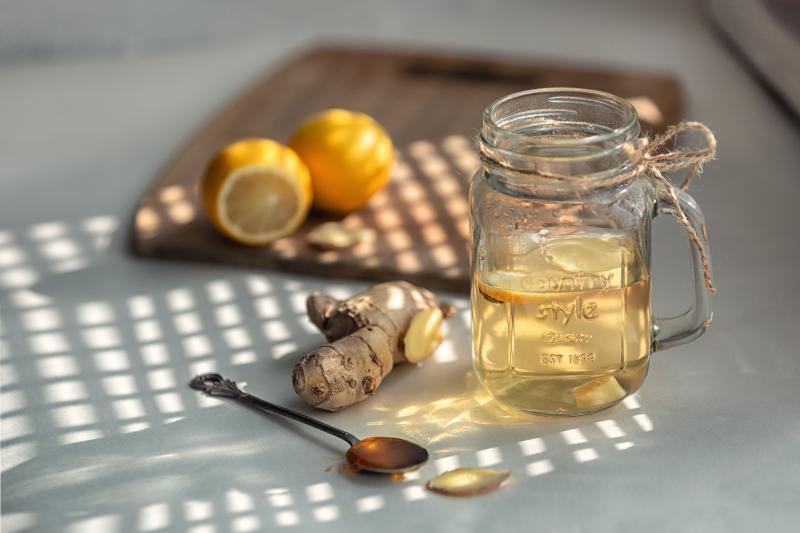Riding the wave of this health-conscious era, I’ve noticed how both fresh and powdered ginger have become indispensable in my kitchen, as well as in those of food lovers everywhere.

Whether it’s adding a spicy kick to a stir-fry or a soothing touch to a cup of tea, ginger has undeniably become a global pantry staple, reflecting our collective shift towards more mindful and healthful eating practices.
As a chef, I find ginger’s blend of flavor, mild acidity, and health benefits utterly fascinating.
Whether I’m using it to add a kick to a meal or as a natural remedy, ginger’s dual role in both cuisine and wellness showcases the delicate balance between taste and health in the most beautiful way.
Delving into the mild acidity of ginger, I’ll uncover its pivotal role in enriching flavor and bolstering health benefits, which stands at the core of our exploration.
Highlights
- Ginger is celebrated both in kitchens for its flavor and in traditional medicine for its health benefits, including anti-inflammatory and digestive properties.
- India leads the world in ginger consumption, utilizing it extensively in both cuisine and herbal remedies.
- With a pH level between 5.6 to 5.9, ginger is mildly acidic, making it a versatile ingredient that’s gentle on most stomachs while offering a spicy kick to dishes.
In this article:
The Culinary Powerhouse with a Healing Touch

In my kitchen, ginger is a secret weapon, not just for its flavor but for its health benefits too.
Its spicy zing can turn a simple stir-fry into a memorable dish, and it’s just as at home in a classic gingerbread cookie as it is in soothing teas.
Despite its mild acidity, it’s a go-to ingredient for both culinary and medicinal uses. Ginger is celebrated for its ability to soothe an upset stomach, eases nausea, and can even alleviate muscle pain.
But here’s the kicker: ginger’s boldness isn’t for every stomach. As a chef, I’ve learned to use ginger judiciously, tailoring its use to suit all palates and digestive tolerances.
Is Ginger Acidic?
Ginger does indeed tip the scales towards the acidic side, with a pH level nestled between 5.6 to 5.9.
In the grand landscape of pH levels, where 0 is highly acidic and 14 is highly alkaline, ginger finds its cozy spot in the mildly acidic zone.
This is quite mellow compared to the sharp acidity of lemon juice, which boasts a pH around 2 to 3, and even more gentle when you consider that pure water sits at a neutral pH of 7.
Comparing Ginger to Other Foods
Now, how does ginger stack up against other foods in terms of acidity? Let’s put it into perspective:
- Lemons and Vinegar: These are on the lower end of the pH scale, with lemons around 2 to 3 and vinegar about 2.5. They’re significantly more acidic than ginger.
- Tomatoes: Often used in cooking for their tangy flavor, tomatoes have a pH around 4.3 to 4.9, making them more acidic than ginger but less so than lemons and vinegar.
- Bananas: These fall into a slightly acidic to neutral category, with a pH around 4.5 to 5.2, placing them close to ginger on the pH scale.
- Spinach: This leafy green is totally alkaline, with a pH above 7.
- Celery: Falling into the alkaline category, celery typically has a pH that can be slightly above 7.
Most vegetables, especially those with high water content like celery or spinach, tend to have a pH that is neutral to slightly alkaline, which would typically place them above 7 on the pH scale.
What Gives Ginger its Unique Taste?

While ginger is generally perceived as mildly acidic, its spicy flavor, attributed to gingerol, the main bioactive compound in ginger, often takes precedence.
This spicy, warm, and sometimes pungent taste tends to dominate ginger’s overall profile. Many people associate ginger’s flavor primarily with its spiciness rather than its acidity.
However, these qualities, which contribute to ginger’s appeal, can also affect how well it’s tolerated by people.
Some individuals may enjoy the zesty kick it brings to dishes, finding it beneficial for stimulating their appetite and aiding digestion without any adverse effects.
Nutritional Content of Ginger
Beyond its well-known compound gingerol, ginger is packed with unique elements that enhance its health benefits:
- Gingerol: the main bioactive compound in ginger, celebrated for its anti-inflammatory and antioxidant effects. It’s what gives ginger its distinctive spicy kick and plays a crucial role in its medicinal properties.
- Shogaols: These compounds emerge during the drying process of ginger and boast strong anti-inflammatory and antioxidant properties, echoing the benefits of gingerol.
- Zingerone: Present in cooked ginger, zingerone is recognized for its antioxidant capabilities and its effectiveness in easing digestive discomfort.
- Paradol: This bioactive compound, also found in ginger, has attracted attention for its antioxidant and potential anti-cancer properties.
- Vitamins and Minerals: Ginger is a source of several vitamins and minerals, including vitamin C, magnesium, potassium, copper, and manganese.
- Dietary Fiber: The dietary fiber in ginger supports digestive health.
Tips for Incorporating Ginger into a Low-Acidity Diet

If you’re navigating a low-acidity diet, ginger can still be a flavorful ally. Here’s how to enjoy its benefits without upsetting your stomach’s pH balance:
- Opt for Fresh Ginger: Fresh ginger is less acidic than dried or powdered forms. Incorporate small amounts into your meals to gauge tolerance.
- Make Ginger Tea: Steeping ginger in hot water can make a soothing, low-acidity drink. You can control the strength by adjusting the amount of ginger and steeping time.
- Cook with Ginger: Adding ginger to your cooked dishes can help neutralize its acidity while imparting flavor. Ginger pairs well with both savory and sweet recipes.
- Ginger Supplements: For those particularly sensitive to acidity but still looking to benefit from ginger’s medicinal properties, ginger supplements may be a viable option. Always consult with a healthcare provider before starting any supplement regimen.
- Balance with Alkaline Foods: Pair ginger with alkaline foods like leafy greens, root vegetables, or cucumbers to balance your meal’s overall pH.
Remember, everyone’s body reacts differently to various foods. Start with small amounts of ginger and observe how your body responds, adjusting your intake accordingly.
Final Thoughts
In the culinary world of trial and error, understanding the nature of ingredients like ginger truly makes all the difference.
As we navigate the kitchen’s highs and lows or tackle dietary restrictions, it becomes evident that knowledge is indeed our best ingredient.
So, let’s keep experimenting, always mindful of how our bodies react to different foods.
And the next time you find yourself grating ginger into your dish or brewing a warm cup of ginger tea, you’ll have a deeper appreciation for its place on the pH scale and its impact on our health.
This journey with ginger not only enhances our culinary creations but also enriches our understanding of food’s role in our well-being.